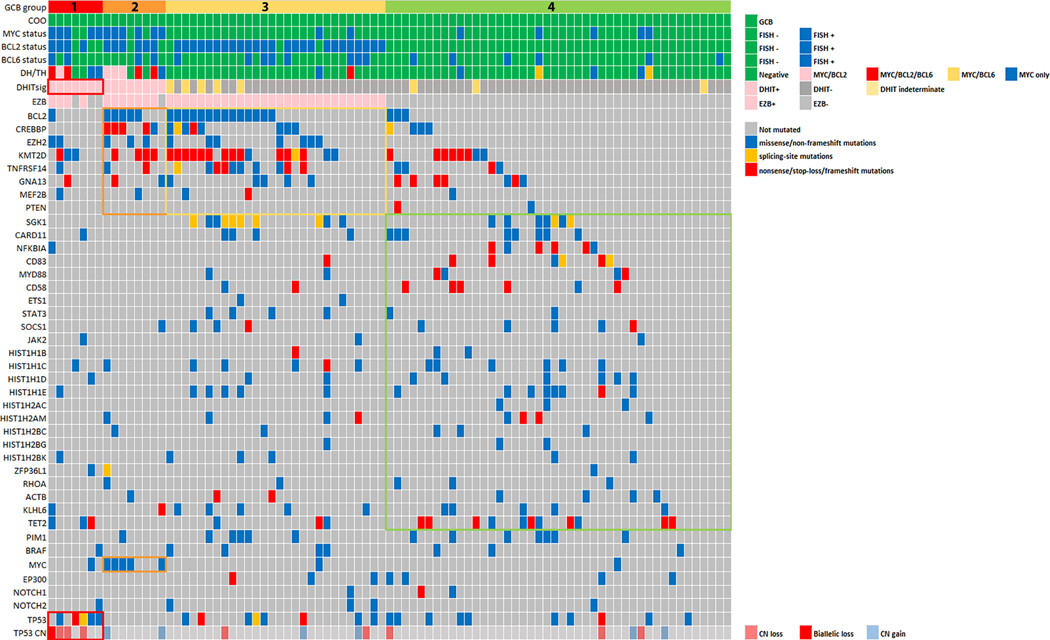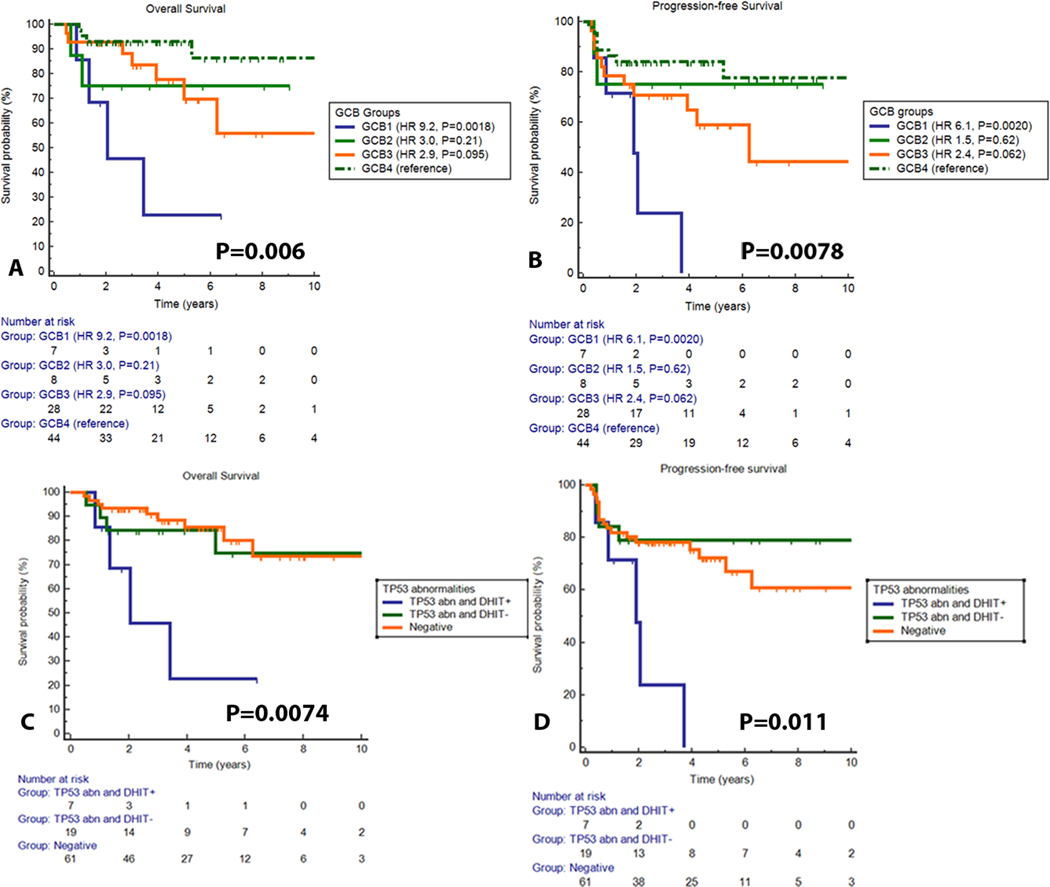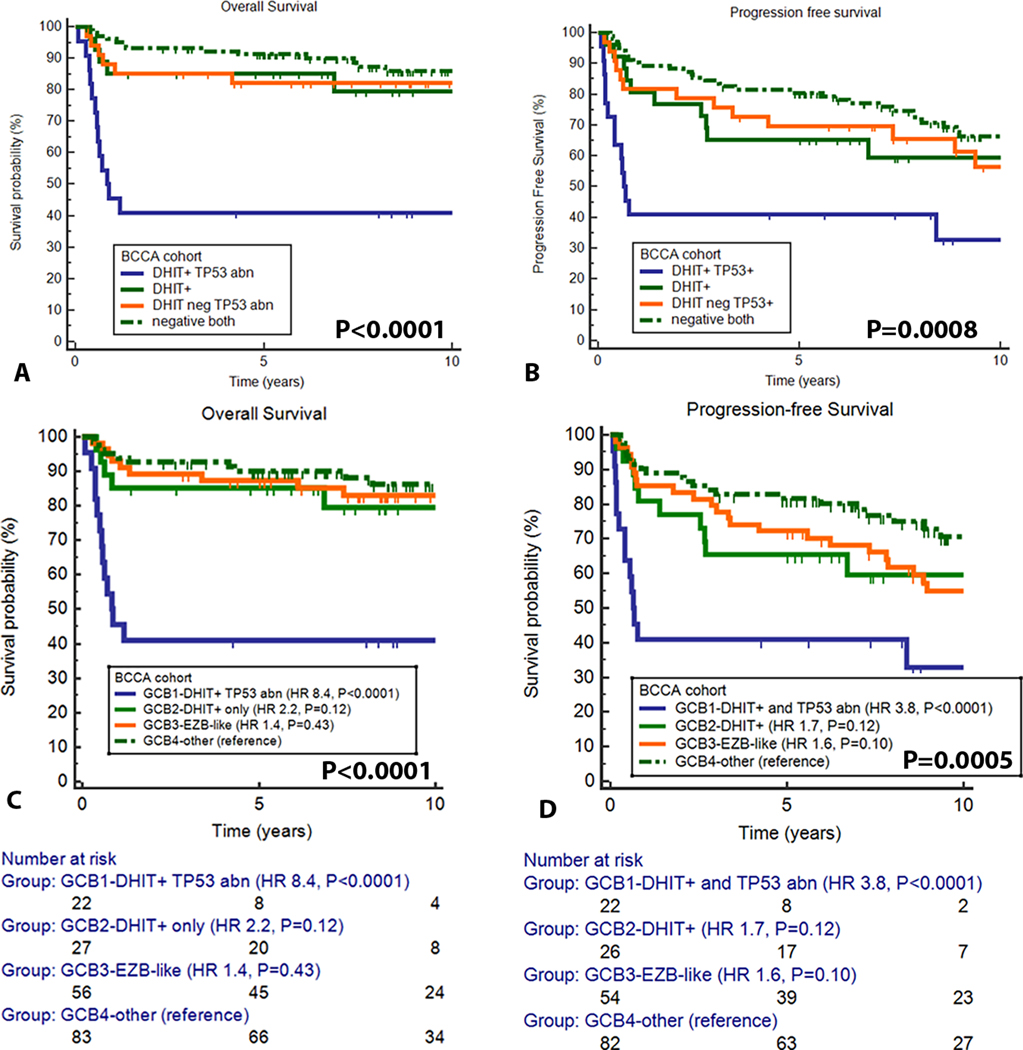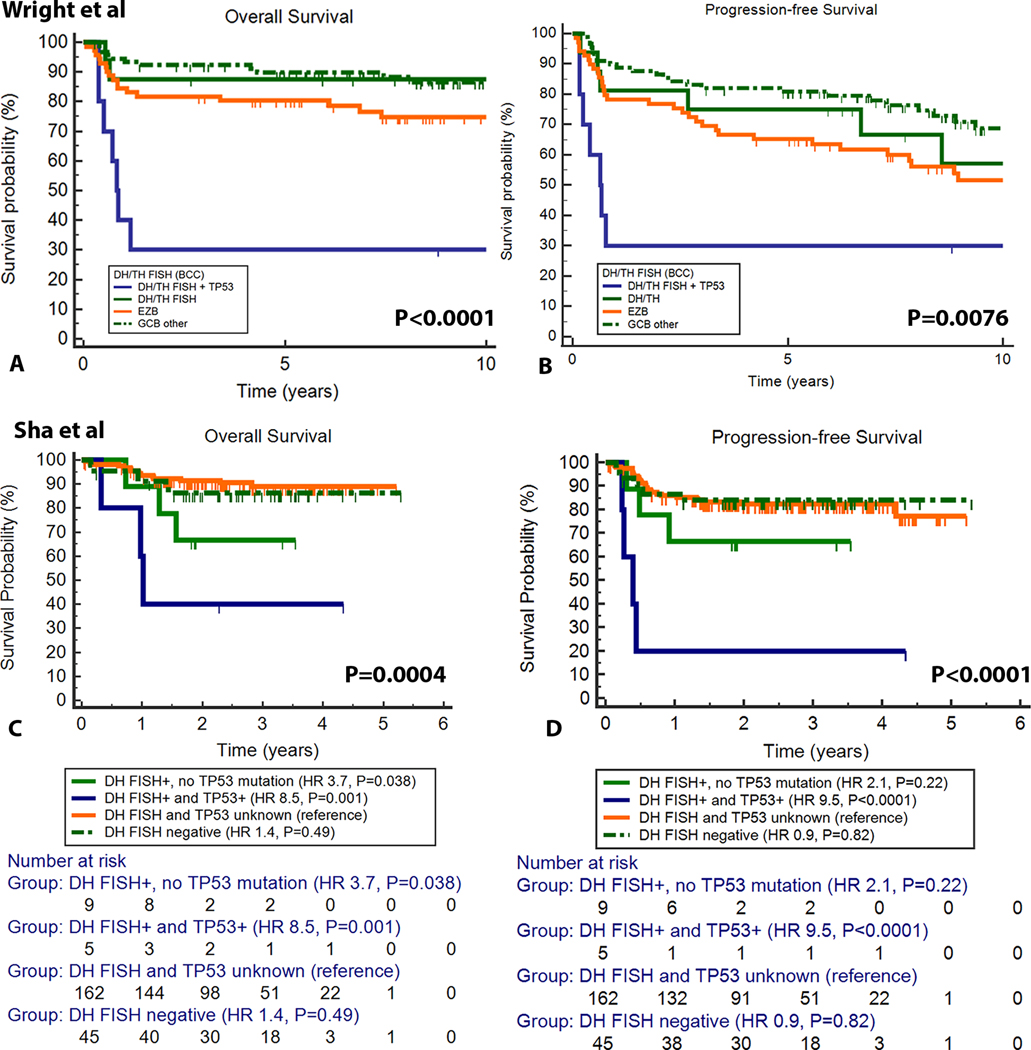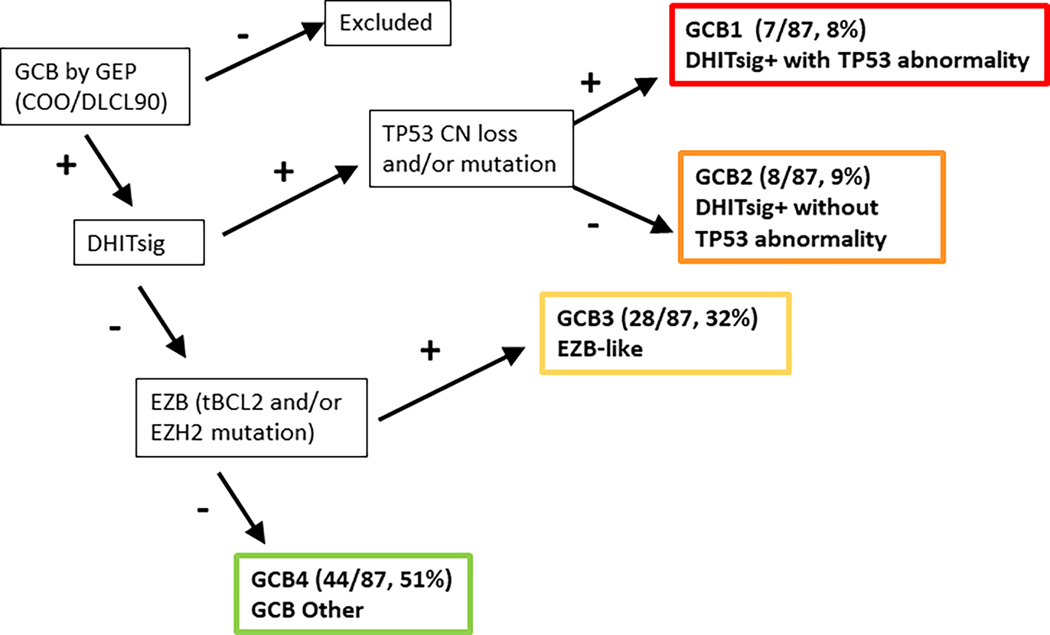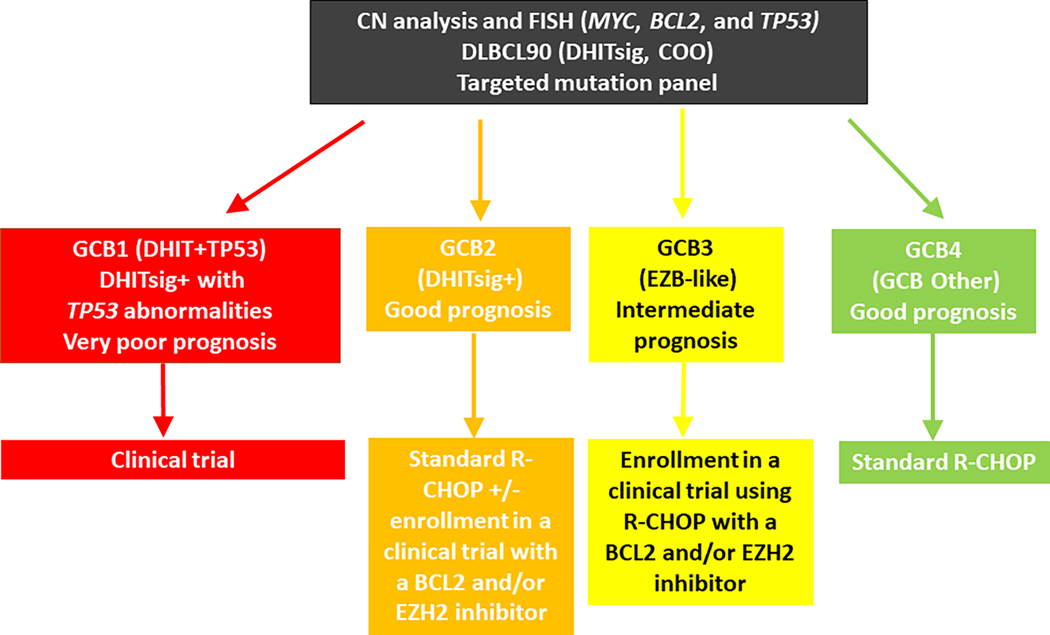Abstract
Purpose:
We performed detailed genomic analysis on 87 cases of de novo diffuse large B-cell lymphoma of germinal center type (GCB DLBCL) to identify characteristics that are associated with survival in those treated with R-CHOP (rituximab, cyclophosphamide, doxorubicin, vincristine, and prednisone).
Experimental Design:
The cases were extensively characterized by combining the results of immunohistochemistry, cell-of-origin gene expression profiling (Nanostring), double-hit gene expression profiling (DLBCL90), fluorescence in situ hybridization (FISH) cytogenetic analysis for double/triple-hit lymphoma, copy number analysis (CNA), and targeted deep sequencing using a custom mutation panel of 334 genes.
Results:
We identified four distinct biologic subgroups with different survivals, and with similarities to the genomic classifications from two large retrospective studies of DLBCL. Patients with the double-hit signature but no abnormalities of TP53, and those lacking EZH2 mutation and/or BCL2 translocation, had an excellent prognosis. However, patients with an EZB-like profile had an intermediate prognosis, whereas those with TP53 inactivation combined with the double-hit signature had an extremely poor prognosis. This latter finding was validated using two independent cohorts.
Conclusions:
We propose a practical schema to utilize genomic variables to risk-stratify patients with GCB DLBCL. This schema provides a promising new approach to identify high-risk patients for new and innovative therapies.
Introduction
Diffuse large B-cell lymphoma (DLBCL) is the most common type of non-Hodgkin lymphoma (NHL), but is a very heterogeneous disease characterized by recurrent chromosomal abnormalities and somatic mutations. The addition of rituximab to CHOP (cyclophosphamide, doxorubicin, vincristine, and prednisone) chemotherapy (R-CHOP) has led to marked improvement in the survival of patients with DLBCL (1). The prognosis of patients with DLBCL has also been associated with biological characteristics of the tumor such as the cell-of-origin (COO) and genetic aberrations. The two major subtypes of DLBCL based on COO are the germinal center B-cell-like (GCB) and activated B-cell-like (ABC) subtypes, as determined by gene expression profiling (GEP) (2,3). The presence of MYC and BCL2 and/or BCL6 translocations, so-called double/triple-hit (DH) lymphoma, has also been shown to predict for an aggressive clinical course in DLBCL (4–6). This observation led the 2017 World Health Organization (WHO) classification to separate the DH cases from DLBCL, not otherwise specified (NOS) (7). Recently, it was reported that GEP could also identify cases with the biological and clinical characteristics of DH lymphoma, including some without the requisite translocations (DHITsig-positive cases) (8). In addition, cases with high MYC and BCL2 protein expression by immunohistochemistry (IHC), so-called dual protein expressors (DPE), were shown to have an inferior survival(4,9). Next generation sequencing has also demonstrated the molecular heterogeneity of this disease, and has provided insights into the pathogenesis and biology of the GCB and ABC subtypes (10–14). Despite the generally good prognosis of GCB DLBCL, a useful prognostic model that could be easily applied in the clinical setting is lacking.
The purpose of this study was to develop a molecular subtyping schema for GCB DLBCL using genomic studies such as fluorescence in situ hybridization (FISH) cytogenetic analysis, gene expression profiling, and mutation analysis to risk-stratify patients with GCB DLBCL.
Methods
Patient cohort
We identified 253 patients diagnosed with de novo DLBCL in the years 2000–2016 at the City of Hope National Medical Center and the University of Manitoba (CancerCare Manitoba) and treated with R-CHOP. There were 87 GCB DLBCL with sufficient material and adequate clinical follow up. Patients with primary mediastinal B-cell lymphoma, T-cell/histiocyte-rich large B-cell lymphoma, prior low-grade B-cell lymphoma, or an immunocompromised state (including human immunodeficiency virus infection) were excluded. Patients were included in the final cohort after the following criteria were met: complete clinical and laboratory data (Table S1), GCB DLBCL by cell-of-origin GEP, and adequate diagnostic biopsy material available for review and multiparameter analysis. This study was approved by the Institutional Review Boards at the City of Hope National Medical Center and University of Manitoba in accordance with the Declaration of Helsinki with a waiver of informed consent obtained for retrospective samples.
Immunohistochemistry and fluorescence in situ hybridization (FISH) cytogenetic analysis on tissue microarrays
Cases with formalin-fixed, paraffin-embedded tissue (FFPET) were stained with hematoxylin and eosin (H&E) and re-reviewed to confirm the diagnosis of DLBCL, NOS. Immunohistochemistry (IHC) was performed on 3–4 micron sections of FFPET microarrays using antibodies to CD20, CD3, CD10, BCL6, MUM1, MYC, and BCL2. The slides were stained on the Ventana Discovery XT platform (Ventana, Tucson, AZ) for MYC, and on a Leica Bond III instrument (Leica Biosystems, Chicago, IL) for all other stains. Cases were reviewed and scored independently by three expert hematopathologists (JYS, AMP, and MRN). FISH cytogenetic analysis for MYC, BCL2 and BCL6 gene rearrangements was performed using the LSI dual color break-apart probes (Abbott Molecular, Des Plaines, IL). At least 100 nuclei were scored and rearrangement was defined as the presence of break-apart signals in ≥ 10% of the nuclei. Double/triple-hit lymphoma (DH) had concurrent rearrangements of MYC and BCL2 and/or BCL6 genes.
Mutation analysis
Tissue blocks in which ≥60% of the surface area consisted of tumor were selected for RNA and DNA extraction using the Qiagen Allprep RNA/DNA FFPET kit (Qiagen, Valencia, CA), following the manufacturer’s recommended protocol. We used a custom targeted panel of 334 genes (designed by QG and WCC), which includes the most frequently mutated genes in B-cell lymphoma, and performed DNA sequencing on an Illumina HiSeq 2500 (Illumina, San Diego, CA) (see Supplemental Material and Table S2).
Copy Number Analysis
The Oncoscan Copy Number Variation (CNV) assay (ThermoFisher, Waltham, MA) was performed according to the manufacturer’s directions using 80 ng of DNA. The data files were analyzed with the Chromosome Analysis Suite (ThermoFisher, Waltham, MA). Briefly, the generation of these files entails calculating the log2 ratio, allelic difference and B-allele frequency (BAF), then identifying normal diploid regions. Based on the normal diploid regions, the log2 ratio, allelic difference, and BAF are recomputed if necessary. Segmentation and visualization of the copy number abnormalities (CNAs) was performed with Nexus Copy Number™ 10.0 software (Bio Discovery, El Segundo, CA) using the SNP-FASST2 algorithm. The percent aberrant genome per case was calculated by taking the total size of the aberrant regions divided by the total size of the genome for chromosomes 1–22.
Gene expression analysis
We used 200 ng of RNA on the nCounter platform (NanoString Technologies, Seattle, WA) to determine the COO using the Lymphoma/Leukemia Molecular Profiling Project (LLMPP) code set Lymph2Cx (3). Briefly, the RNA was hybridized to custom code sets overnight at 65°C and processed on the nCounter Prep Station, and gene expression data was acquired on the nCounter Digital Analyzer. We then uploaded the data to the LLMPP website (https://llmpp.nih.gov), which generated the COO using the nSolver (NanoString Technologies, Seattle, WA). In addition, we also ran the DLBCL90 double-hit gene expression signature (8) on the nSolver. The DHIT score was defined as DHITsig-positive (greater than −6.3), DHITsig-negative (less than −15.6), or DHITsig-indeterminant (−6.3 to −15.6).
GCB DLBCL grouping
The grouping of GCB DLBCL was performed as follows in a step-wise manner (from GCB1 to GCB4):
GCB1:
Cases that had TP53 abnormalities (homozygous TP53 loss or TP53 copy number loss and/or TP53 mutation) and were DHITsig-pos were categorized into GCB1. TP53 abnormalities are frequently seen in DHITsig-pos cases(8) and, since they are a strong independent prognostic factor in DLBCL(15,16), we investigated TP53 abnormalities in conjunction with DHITsig GEP status.
GCB2:
The remaining cases that were DHITsig-pos but lacking TP53 abnormalities were categorized as GCB2.
GCB3:
Cases that had an EZH2 mutation and/or BCL2 translocation, similar to the EZB group (17), but were DHITsig-neg, were categorized in GCB3.
GCB4:
The remaining cases that lacked DHITsig-pos and were not EZB (lacked EZH2 mutation and/or BCL2 translocation) (Figure 1).
Figure 1.
Most frequent mutations in 87 cases of GCB DLBCL. GCB1 are DHITsig-pos cases with TP53 abnormalities. GCB2 corresponds to the DHITsig-pos cases without TP53 abnormalities. GCB3 are cases with EZH2 mutation and/or BCL2 translocations and DHITsig-neg. The top 2 boxes (orange and yellow) correspond to Cluster 3 of Chapuy et al(20). GCB4 is similar to Cluster 4 of Chapuy et al(20) with a high frequency of SGK1 mutations and histone linker mutations.
External validation cohort
We used data from the study by Wright et al(14) for 188 patients diagnosed with GCB DLBCL who were treated with R-CHOP. We recategorized these cases with our new grouping method as follows: cases that had a TP53 abnormalities and DHITsig-pos as GCB1; cases that were negative for TP53 abnormalities but DHITsig-pos as GCB2; cases with EZH2 mutation and/or BCL2 translocation as GCB3; and the remaining cases as GCB4. We also used the data from 221 patients diagnosed with GCB DLBCL and treated with R-CHOP from the study of Sha et al (18) to determine if TP53 mutated cases with double-hit MYC/BCL2 by FISH analysis also had a poor prognosis.
Statistical analysis
Overall survival (OS) and progression-free survival (PFS) were calculated as the time from initial diagnosis to death due to any cause (OS), or to the earliest of refractory disease, relapse, or death due to any cause (PFS). Patients alive at the last contact (OS) or patients alive without refractory/relapsed disease (PFS) were censored at the last contact. OS and PFS were estimated using the Kaplan-Meier product-limit method (19). Hazard ratios (HR) and P values were determined using the Cox model. All P values were 2-sided and analyses were performed using SAS 9.4. Survival curves were generated using MedCalc Statistical Software version 19.1.5 (MedCalc Software bv, Ostend, Belgium).
Results
A total of 87 patients with GCB DLBCL (median age 60 years, male-to-female ratio 1.7:1) had complete clinical, IHC, FISH, GEP, and sequencing data (Tables S1 and S3). There was no difference in OS between the two centers (P=0.50). There were a total of 11 DH/TH lymphomas identified by FISH analysis: 4 MYC/BCL2 double-hit lymphomas, 5 MYC/BCL2/BCL6 triple-hit lymphomas, and 2 MYC/BCL6 double-hit lymphomas. Fifteen cases had the double-hit signature (DHITsig-positive), 8 were indeterminant, and 64 cases were DHITsig-negative using the DLBCL90 gene expression signature of Ennishi et al(8) (Figure 1 and Figure S1). The 8 indeterminant cases had survival outcomes similar to those who were DHITsig-negative and were analyzed together as one group for OS and PFS.
We also analyzed the cases for TP53 abnormalities (TP53 CN loss and/or TP53 mutations) independent of DHITsig as well as EZH2 and/or BCL2 translocations (EZB) and found there was no significant difference in OS (P=0.2 and P=0.09, respectively) (Figure S2). We therefore investigated whether combining these factors could improve prognostication.
GCB DLBCL grouping
GCB1: DHITsig-pos with TP53 inactivation (DHIT+TP53):
DLBCL with TP53 mutations and/or deletions has a poor prognosis in patients treated with R-CHOP(15,16). We found 7 cases (8% of all cases) of GCB DLBCL that were DHITsig-pos with TP53 abnormalities. By FISH analysis, two cases had a triple-hit, one was double-hit with MYC/BCL2, 2 cases had a MYC translocation only, one case had a BCL2 translocation only, and the other case had no such translocation. Cases in GCB1 had the worst overall survival (OS; HR 9.2, P=0.0018) and shortest progression-free survival (PFS; HR 6.1, P=0.002) compared to other groups (Figures 2A and 2B). Patients with TP53 abnormalities that were DHITsig-neg did not have the same poor survival (Figures 2C and 2D).
Figure 2.
Training cohort (N=87). A and B. Overall survival and progression-free survival in the genomic subgroups of germinal center type diffuse large B-cell lymphoma (GCB DLBCL) treated with R-CHOP. GCB1 (TP53 abnormalities with DHITsig-pos) had very poor survival, whereas GCB3 (EZH2 mutation and/or BCL2 translocation) had an intermediate survival. Removing the cases with TP53 abnormalities from the DHITsig-pos cases improved the OS and PFS of the DHITsig-pos cases (GCB2). Cases in GCB4 had an excellent survival. C and D. Overall and progression-free survival in germinal center type diffuse large B-cell lymphoma (GCB DLBCL) with reference to TP53 abnormalities. Patients with TP53 abnormalities in conjunction with DHITsig-pos (blue) had very poor survival. However, patients that had TP53 abnormalities without DHITsig-pos (green) had excellent survival.
GCB2: DHITsig-positive (DHITsig-pos):
The other 8 cases (9%) that were DHITsig-pos but lacked TP53 abnormalities showed a predilection (88%) for having an EZH2 mutation and/or BCL2 translocation (EZB of Schmitz et al (17)). These cases also had a high frequency of MYC mutations (63%) but lacked mutations in SGK1 (0%), and had a low frequency of mutations in linker histone genes (e.g. HIST1H1E) (Figure 1). By FISH analysis, 3 cases were double-hit lymphoma with MYC/BCL2, 2 cases were triple-hit lymphoma with MYC/BCL2/BCL6, 1 case had a MYC translocation only, one had a BCL2 translocation only, and the other one had no such translocation. Typically DHITsig-pos cases have a poor overall survival when compared to DHITsig-neg cases(8), but this group had a good survival in our study after removing the cases with TP53 abnormalities (Figures 2A and 2B).
GCB3: DHITsig-neg and EZH2 mutated and/or BCL2 translocation (EZB-like):
There were 28 cases (32%) that were DHITsig-neg and had an EZH2 mutation and/or BCL2 translocation. These were categorized as EZB-like with some overlapping features with the DLBCL in Cluster 3 of Chapuy et al(20). These cases showed frequent mutations of BCL2 (50%), KMT2D (57%), TNFRSF14 (36%), SGK1 (36%), and histone modifying genes (39%), but mutations of MYC were infrequent (4%) (Figure 1). The survival of this group was intermediate compared to the other groups (Figures 2A and 2B).
GCB4: DHITsig-neg and not EZB-like (GCB Other):
The largest group of cases (51%) was DHITsig-neg and lacked EZH2 mutations and/or BCL2 translocations. These cases had frequent mutations in SGK1 (16%) and histone modifying genes (50%), as well as TET2 mutations (25%) (Figure 1). These cases have similarities to Cluster 4 of Chapuy et al(20). The survival of this group was excellent (Figures 2A and 2B).
External Validation:
Using an independent cohort of 188 patients with GCB DLBCL treated with R-CHOP from the study by Wright et al(14), we found that cases that were DHITsig-pos with any TP53 abnormality (biallelic, CN loss, and/or mutation) had a poor OS and PFS (Figures 3A and 3B, and Figure S3), whereas those with a TP53 abnormality that were DHITsig-neg did not show such poor survival. We then grouped the validation cohort cases using our GCB grouping strategy and observed that the GCB1 (DHITsig-pos with TP53 abnormalities) had very poor OS (HR 8.4, P<0.0001) and PFS (HR 3.8, P<0.0001) just as we saw in our training cohort (Figures 3C and 3D, and Figure S4). We also observed that within particular IPI groups, GCB1 identified patients with the poorest survival (Figure S5). For GCB2 (HR 2.2, P=0.12) and GCB3 (HR 1.4, P=0.43), the OS was similar to GCB4 but there was a trend for a shorter PFS for GCB2 (HR 1.7, P=0.12) and GCB3 (HR 1.6, P=0.1) (Figure 3C and 3D). In addition, we found that cases that were DH/TH by FISH analysis (MYC/BCL2 or MYC/BCL2/BCL6) combined with TP53 abnormalities had the poorest OS (P<0.0001) and PFS (P=0.0076) (Figure 4A and 4B).
Figure 3.
Overall survival and progression-free survival in a validation cohort of 188 patients (14). A and B. The DHITsig-pos cases with TP53 abnormalities (DHIT+ TP53 abn, blue) have a very poor survival compared to cases with DHITsig-pos alone (DHIT+, green solid). Cases that were DHITsig-neg but had TP53 abnormalities (DHIT neg TP53+, orange) had a good survival, as did cases that were negative for both DHITsig and TP53 abnormalities (negative both, green dash). C and D. Applying our GCB grouping strategy, we were able to confirm our findings in the training cohort.
Figure 4.
A and B. Overall survival (OS) and progression-free survival (PFS) of patients from Wright et al (7) with DH/TH lymphoma by FISH analysis (MYC/BCL2 and MYC/BCL2/BCL6) combined with TP53 abnormalities. These cases (blue line) had poor OS and PFS. C and D. OS and PFS of an independent cohort of 221 patients from Sha et al (18) showing that those with a MYC/BCL2 genetic double-hit by FISH cytogenetic analysis and TP53 mutation had very poor survival.
We also used a second independent cohort of 221 patients with GCB DLBCL treated with R-CHOP from the REMoDL-B trial(18,21). However, for this cohort, we were only able to use the TP53 mutation status as the sole TP53 abnormality in our analysis since CNA was not available. We also did not have GEP for the DHITsig, so instead we used the FISH analysis as a surrogate for the DHITsig. Although there is not a direct correlation with the DHITsig, we found that cases that were double-hit with MYC/BCL2 by FISH and had a TP53 mutation had a much shorter OS (HR 8.5, P=0.001) and PFS (HR 9.5, P<0.0001) (Figure 4C and 4D). These two studies support our finding that having a double-hit profile by GEP or FISH analysis in conjunction with a TP53 abnormality results in very poor survival in patients with GCB DLBCL.
Discussion
Several recent studies have elucidated the genomic diversity of DLBCL and reported various subgroups with distinct biologic pathways (8,13,14,17,18,20). However, this is the first study of its kind to incorporate FISH cytogenetic analysis, GEP using the DLBCL90 signature(8), targeted sequencing and copy number analysis to risk-stratify patients with GCB DLBCL treated with R-CHOP (Figure 5). By combining these modalities, we found that cases with TP53 abnormalities that are DHITsig-pos (GCB1) have a very poor prognosis, whereas cases that are DHITsig-neg and lack EZH2 mutations and BCL2 translocations (GCB4) have an excellent prognosis when treated with R-CHOP. Interestingly, patients who are DHITsig-pos but lack TP53 abnormalities also have a good prognosis (GCB2), whereas those in the EZB-like group (GCB3) have an intermediate prognosis. We believe that these methods can be used to better risk-stratify patients with GCB DLBCL for clinical studies.
Figure 5.
Decision tree for grouping germinal center type diffuse large B-cell lymphoma (GCB DLBCL). Only cases with a GCB GEP by Lymph2Cx and DLBCL90 are included. Cases who were DHITsig-pos with TP53 abnormality (copy number (CN) loss and/or TP53 mutation) are included in GCB1. Cases without TP53 abnormalities but DHITsig-pos are included in GCB2. Cases that have a BCL2 translocation (tBCL2) and/or an EZH2 mutation (EZB-like) are included in GCB3. The remaining cases were grouped together in GCB4.
Recently, six studies looking at the biology of DLBCL have demonstrated various genetic profiles important in lymphomagenesis(8,13,14,17,18,20). Wright et al(14) and Schmitz et al(17) have identified a subgroup of GCB DLBCL with EZH2 mutations and/or BCL2 translocations (EZB group) that had a less favorable outcome than patients without these lesions. Chapuy et al(20) have recently identified five distinct clusters of DLBCL. They divided GCB DLBCL into two clusters, one similar to the EZB group (Cluster 3), and the other enriched in mutations affecting core and linker histones and mutations in the GNA13/RhoA, JAK/STAT and BRAF pathways (Cluster 4), with a more favorable outcome than Cluster 3. They also found a cluster characterized by biallelic inactivation of TP53 and/or CDKN2A loss with an unfavorable prognosis (Cluster 2). The studies by Wright et al(14), Schmitz et al(17), and Chapuy et al(20) all demonstrate differences in the biologic groupings, but there is clearly extensive overlap for some of the groups. Recent studies by Ennishi et al(8) and Sha et al(18) used GEP to develop a signature that is sensitive and specific for identifying high-grade B-cell lymphomas with features of DH lymphoma regardless of the status of MYC and BCL2 translocations (DHITsig-pos and MHG, respectively). These cases had poor survival, similar to those with ABC DLBCL, and had a significant association with the EZB group proposed by Schmitz et al(17). Interestingly, cases that were DHITsig-pos had a higher frequency of TP53 mutations compared to those that were DHITsig-neg(8). It is well known that TP53 abnormalities in DLBCL are associated with a poor prognosis (15,16) and, since we saw that a subset of the DHITsig-pos cases had TP53 abnormalities, it was of interest to investigate this issue. In addition, both Chapuy et al (20) and Schmitz et al (17) showed that the EZB-like have an intermediate prognosis in GCB DLBCL. We believe that our algorithm is an improvement with prognostic implications.
We found that our cases with TP53 abnormalities that also were DHITsig-pos (GCB1, DHIT+TP53) had a very poor prognosis (Figure 2). This finding was validated in an independent cohort (14) of cases showing poor survival for those who were DHITsig-pos with TP53 abnormalities (Figure 3). In both validation cohorts (14,18), we also found that double-hit cases with MYC/BCL2 by FISH analysis with TP53 mutations had a poor survival (Figure 4). Other studies of DLBCL have also shown that mutations and copy number loss of TP53 are associated with a poor prognosis (15,16). TP53 mutation in combination with copy number loss results in p53 deficiency and the inability to eliminate damaged cells(15). Our cases that were DHITsig-pos with TP53 abnormalities had a dismal prognosis, which confirms that the TP53 abnormality is key to the aggressiveness of these lymphomas. This is also consistent with recent findings that not all double- or triple-hit lymphomas have a poor prognosis(22,23). In fact, our GCB2 group, which are the cases that were DHITsig-pos but lacked TP53 abnormalities, had a good prognosis despite the fact that many of these cases were double- or triple-hit lymphomas by FISH analysis (Figures 2 and 3). This emphasizes the need to test for the DHITsig by GEP in conjunction with TP53 mutation and CNA to identify these high-risk patients. Cases that were DHITsig-neg with TP53 abnormalities did not have a similar poor prognosis, likely due to residual TP53 function (Figures 2 and 3). We believe the DHITsig is more robust and identifies more cases with a double-hit-like biology and clinical behavior but FISH analysis for DH/TH may be used if GEP is not readily available.
We found that the DHITsig-pos cases without TP53 abnormalities (GCB2) had a relatively good survival, thus supporting this separation as significant from both the molecular and biological standpoints. Although our GCB2 and GCB3 groups had similarity to the EZB group of Schmitz et al(17), we divided them according to the presence or absence of the DHITsig with the positive ones assigned to GCB2. With the removal of the DHITsig-pos cases, the EZB-like group (GCB3) had an intermediate survival indicating that these groups may be important to distinguish.
The cases in GCB3 (EZB-like) and GCB4 showed a higher proportion of mutations in SGK1, CARD11, and histone linker genes (e.g. HIST1H1E), and GCB4 also showed a higher proportion of TET2 mutations (25%) compared GCB3 (11%). We found that GCB4 has a mutation pattern similar to Cluster 4 of Chapuy et al(20) with a good prognosis, whereas GCB3 is similar to Cluster 3 or the EZB group with a high frequency of BCL2 translocations, and BCL2, CREBBP, and KMT2D mutations. However, Cluster 3 also includes a proportion of DHITsig-pos cases, which we separated out in our study (GCB2) as a distinct biologic subgroup. We found that GCB3 had an intermediate prognosis when compared to GCB4 in our training cohort but saw less of a difference in the validation cohort. These differences may be due to sample size and a larger cohort is necessary to resolve these findings.
By using this risk stratification of GCB DLBCL, R-CHOP is sufficient to treat patients with GCB2 and GCB4, but patients with GCB3 may benefit from novel approaches, such as inclusion of an EZH2 or BCL2 inhibitor (Figure 6). Patients with GCB1 should be enrolled onto clinical trials evaluating novel therapeutic approaches such as CD19-directed chimeric antigen receptor (CAR) T-cells, which are being evaluated as part of frontline therapy in patients with double- or triple-hit DLBCL (NCT03761056, https://clinicaltrials.gov/ct2/show/NCT03761056).
Figure 6.
Using copy number (CN) analysis and FISH cytogenetics for TP53, MYC and BCL2, in conjunction with DLBCL90 GEP analysis (cell of origin, DHITsig) and a targeted mutation panel, cases of germinal center type (GCB) diffuse large B-cell lymphoma (DLBCL) can be risk-stratified for various therapies. GCB1 has a very poor prognosis when treated with R-CHOP therapy should be enrolled in a clinical trial. Patients with GCB2 could be treated with standard R-CHOP with or without a BCL2 or EZH2 inhibitor. Patients with GCB3 would benefit from enrollment onto a clinical trial using R-CHOP in conjunction with an EZH2 and/or BCL2 inhibitor, whereas GCB4 will benefit from R-CHOP alone.
There are some limitations to our study, which include the retrospective nature of the study and the long time to accrue the cases, which may have led to an inherent selection bias. We tried to minimize this by including consecutive cases from the general population (Canadian territories such as Manitoba in the training cohort, and British Columbia in the validation cohort). We also realize that these sample size in the study and validation cohorts is small and acknowledge that more cases need to be studied in the future to confirm our findings.
In conclusion, we found that patients who are DHITsig-pos with TP53 abnormalities have a dismal prognosis and represent the highest risk subgroup of patients with GCB DLBCL. In contrast, DHITsig-pos cases without TP53 abnormalities (GCB2) have a good prognosis, EZB-like cases (GCB3) without the DHITsig have an intermediate prognosis, and cases that are DHITsig-neg and lack an EZH2 mutation and/or BCL2 translocation (GCB4) have an excellent prognosis when treated with R-CHOP. Although analysis of more cases is necessary to confirm our findings, we believe that using just the DLBCL90 GEP, mutation profiling for TP53 and EZH2, and copy number analysis for TP53, simplifies the prognostication of these patients and identifies those who may benefit from novel therapies or enrollment in a clinical trial.
Supplementary Material
Translational relevance:
TP53 inactivation in combination with the double-hit gene expression signature in GCB DLBCL identifies a group of patients with a very poor prognosis. Patients with a double-hit gene expression signature but lacking TP53 abnormalities showed good survival. This study shows that it is important to analyze TP53 abnormalities in conjunction with double-hit gene expression signature to risk stratify these patients for novel therapies.
Acknowledgements
This research was supported by the City of Hope National Medical Center Department of Pathology and the Toni Stephenson Lymphoma Center. Research reported in this publication included work performed in the Pathology Core and Integrated Genomics Core supported by the National Cancer Institute of the National Institutes of Health under grant number P30CA033572. The content is solely the responsibility of the authors and does not necessarily represent the official views of the National Institutes of Health.
Footnotes
Disclosure/Conflict of Interest: DWS is a named inventor on a patent describing the “double-hit signature” and the DLBCL90 assay. No other authors have conflicts of interest.
References
- 1.Coiffier B, Thieblemont C, Van Den Neste E, Lepeu G, Plantier I, Castaigne S, et al. Long-term outcome of patients in the LNH-98.5 trial, the first randomized study comparing rituximab-CHOP to standard CHOP chemotherapy in DLBCL patients: a study by the Groupe d’Etudes des Lymphomes de l’Adulte. Blood 2010;116(12):2040–5 doi 10.1182/blood-2010-03-276246. [DOI] [PMC free article] [PubMed] [Google Scholar]
- 2.Alizadeh AA, Eisen MB, Davis RE, Ma C, Lossos IS, Rosenwald A, et al. Distinct types of diffuse large B-cell lymphoma identified by gene expression profiling. Nature 2000;403(6769):503–11. [DOI] [PubMed] [Google Scholar]
- 3.Scott DW, Wright GW, Williams PM, Lih CJ, Walsh W, Jaffe ES, et al. Determining cell-of-origin subtypes of diffuse large B-cell lymphoma using gene expression in formalin-fixed paraffin-embedded tissue. Blood 2014;123(8):1214–7 doi 10.1182/blood-2013-11-536433. [DOI] [PMC free article] [PubMed] [Google Scholar]
- 4.Johnson NA, Slack GW, Savage KJ, Connors JM, Ben-Neriah S, Rogic S, et al. Concurrent expression of MYC and BCL2 in diffuse large B-cell lymphoma treated with rituximab plus cyclophosphamide, doxorubicin, vincristine, and prednisone. Journal of clinical oncology : official journal of the American Society of Clinical Oncology 2012;30(28):3452–9 doi 10.1200/JCO.2011.41.0985. [DOI] [PMC free article] [PubMed] [Google Scholar]
- 5.Horn H, Ziepert M, Becher C, Barth TF, Bernd HW, Feller AC, et al. MYC status in concert with BCL2 and BCL6 expression predicts outcome in diffuse large B-cell lymphoma. Blood 2013;121(12):2253–63 doi 10.1182/blood-2012-06-435842. [DOI] [PubMed] [Google Scholar]
- 6.Pillai RK, Sathanoori M, Van Oss SB, Swerdlow SH. Double-hit B-cell lymphomas with BCL6 and MYC translocations are aggressive, frequently extranodal lymphomas distinct from BCL2 double-hit B-cell lymphomas. The American journal of surgical pathology 2013;37(3):323–32 doi 10.1097/PAS.0b013e31826cebad. [DOI] [PubMed] [Google Scholar]
- 7.Swerdlow S, Campo E, Harris NL, Jaffe ES, Pileri SA, Stein H, Thiele J, Arber DA, Hasserjian RP, Le Beau MM, Orazi A, and Siebert R. WHO classification of Tumours of Haematopoietic and Lymphoid Tissues. Lyon, France: International Agency for Research on Cancer; 2017. [Google Scholar]
- 8.Ennishi D, Jiang A, Boyle M, Collinge B, Grande BM, Ben-Neriah S, et al. Double-Hit Gene Expression Signature Defines a Distinct Subgroup of Germinal Center B-Cell-Like Diffuse Large B-Cell Lymphoma. Journal of clinical oncology : official journal of the American Society of Clinical Oncology 2019;37(3):190–201 doi 10.1200/JCO.18.01583. [DOI] [PMC free article] [PubMed] [Google Scholar]
- 9.Green TM, Young KH, Visco C, Xu-Monette ZY, Orazi A, Go RS, et al. Immunohistochemical Double-Hit Score Is a Strong Predictor of Outcome in Patients With Diffuse Large B-Cell Lymphoma Treated With Rituximab Plus Cyclophosphamide, Doxorubicin, Vincristine, and Prednisone. Journal of Clinical Oncology 2012;30(28):3460–7 doi 10.1200/jco.2011.41.4342. [DOI] [PubMed] [Google Scholar]
- 10.Morin RD, Mungall K, Pleasance E, Mungall AJ, Goya R, Huff RD, et al. Mutational and structural analysis of diffuse large B-cell lymphoma using whole-genome sequencing. Blood 2013;122(7):1256–65 doi 10.1182/blood-2013-02-483727. [DOI] [PMC free article] [PubMed] [Google Scholar]
- 11.Zhang J, Grubor V, Love CL, Banerjee A, Richards KL, Mieczkowski PA, et al. Genetic heterogeneity of diffuse large B-cell lymphoma. Proceedings of the National Academy of Sciences of the United States of America 2013;110(4):1398–403 doi 10.1073/pnas.1205299110. [DOI] [PMC free article] [PubMed] [Google Scholar]
- 12.Pasqualucci L, Trifonov V, Fabbri G, Ma J, Rossi D, Chiarenza A, et al. Analysis of the coding genome of diffuse large B-cell lymphoma. Nature genetics 2011;43(9):830–7 doi 10.1038/ng.892. [DOI] [PMC free article] [PubMed] [Google Scholar]
- 13.Reddy A, Zhang J, Davis NS, Moffitt AB, Love CL, Waldrop A, et al. Genetic and Functional Drivers of Diffuse Large B Cell Lymphoma. Cell 2017;171(2):481–94 e15 doi 10.1016/j.cell.2017.09.027. [DOI] [PMC free article] [PubMed] [Google Scholar]
- 14.Wright GW, Huang DW, Phelan JD, Coulibaly ZA, Roulland S, Young RM, et al. A Probabilistic Classification Tool for Genetic Subtypes of Diffuse Large B Cell Lymphoma with Therapeutic Implications. Cancer Cell 2020;37(4):551–68 e14 doi 10.1016/j.ccell.2020.03.015. [DOI] [PMC free article] [PubMed] [Google Scholar]
- 15.Monti S, Chapuy B, Takeyama K, Rodig Scott J, Hao Y, Yeda Kelly T, et al. Integrative Analysis Reveals an Outcome-Associated and Targetable Pattern of p53 and Cell Cycle Deregulation in Diffuse Large B Cell Lymphoma. Cancer Cell 2012;22(3):359–72 doi 10.1016/j.ccr.2012.07.014. [DOI] [PMC free article] [PubMed] [Google Scholar]
- 16.Xu-Monette ZY, Wu L, Visco C, Tai YC, Tzankov A, Liu W-m, et al. Mutational profile and prognostic significance of TP53 in diffuse large B-cell lymphoma patients treated with R-CHOP: report from an International DLBCL Rituximab-CHOP Consortium Program Study. Blood 2012;120(19):3986–96 doi 10.1182/blood-2012-05-433334. [DOI] [PMC free article] [PubMed] [Google Scholar]
- 17.Schmitz R, Wright GW, Huang DW, Johnson CA, Phelan JD, Wang JQ, et al. Genetics and Pathogenesis of Diffuse Large B-Cell Lymphoma. The New England journal of medicine 2018;378(15):1396–407 doi 10.1056/NEJMoa1801445. [DOI] [PMC free article] [PubMed] [Google Scholar]
- 18.Sha C, Barrans S, Cucco F, Bentley MA, Care MA, Cummin T, et al. Molecular High-Grade B-Cell Lymphoma: Defining a Poor-Risk Group That Requires Different Approaches to Therapy. Journal of Clinical Oncology 2019;37(3):202–12 doi 10.1200/jco.18.01314. [DOI] [PMC free article] [PubMed] [Google Scholar]
- 19.Kaplan EL, Meier P. Nonparametric estimation from incomplete observations. Journal of the American statistical association 1958;53(282):457–81. [Google Scholar]
- 20.Chapuy B, Stewart C, Dunford AJ, Kim J, Kamburov A, Redd RA, et al. Molecular subtypes of diffuse large B cell lymphoma are associated with distinct pathogenic mechanisms and outcomes. Nat Med 2018;24(5):679–90 doi 10.1038/s41591-018-0016-8. [DOI] [PMC free article] [PubMed] [Google Scholar]
- 21.Davies A, Cummin TE, Barrans S, Maishman T, Mamot C, Novak U, et al. Gene-expression profiling of bortezomib added to standard chemoimmunotherapy for diffuse large B-cell lymphoma (REMoDL-B): an open-label, randomised, phase 3 trial. The Lancet Oncology 2019;20(5):649–62 doi 10.1016/s1470-2045(18)30935-5. [DOI] [PMC free article] [PubMed] [Google Scholar]
- 22.Pedersen MO, Gang AO, Poulsen TS, Knudsen H, Lauritzen AF, Nielsen SL, et al. Double-hit BCL2/MYC translocations in a consecutive cohort of patients with large B-cell lymphoma - a single centre’s experience. European journal of haematology 2012;89(1):63–71 doi 10.1111/j.1600-0609.2012.01787.x. [DOI] [PubMed] [Google Scholar]
- 23.Li S, Lin P, Fayad LE, Lennon PA, Miranda RN, Yin CC, et al. B-cell lymphomas with MYC/8q24 rearrangements and IGH@BCL2/t(14;18)(q32;q21): an aggressive disease with heterogeneous histology, germinal center B-cell immunophenotype and poor outcome. Modern pathology : an official journal of the United States and Canadian Academy of Pathology, Inc 2012;25(1):145–56 doi 10.1038/modpathol.2011.147. [DOI] [PubMed] [Google Scholar]
Associated Data
This section collects any data citations, data availability statements, or supplementary materials included in this article.



